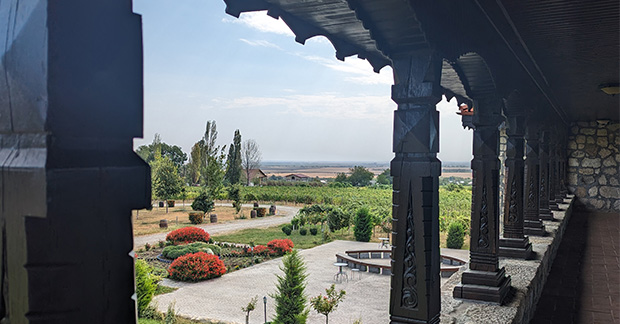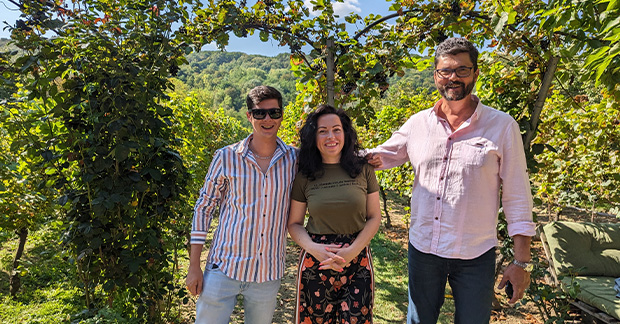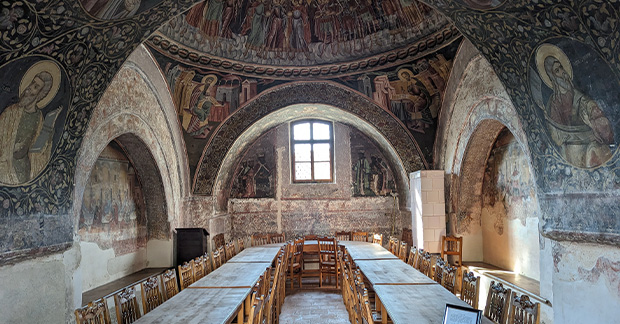You are viewing 2 of your 2 free articles
Fine wine and fascinating history on Regent’s latest Romania tour
A new Romania tour from Regent Holidays pairs a fresh generation of wineries with historic churches and castles, writes Katie McGonagle
Click here to download and save as a PDF
This small business started from a big passion,” says winemaker Ferdi, as he decants a bottle of his signature red, Cuvee Paul Rezerva, which he named after his son (now business partner). “I decided in 2009 to make my own wine, so I would know exactly what goes into it, and I make the wine exactly how I love to drink it.
“Everything is done manually, from picking the grapes and cutting the vines to bottling. Everything is done with our own hands, so we pick only grapes that are healthy and at their full potential. It’s a lot of work, but we are trying to make some quality wine here.” After a career change from marine officer to restaurateur, Fernando Mih?ilescu – Ferdi to friends – ultimately decided to pursue his passion for winemaking by turning a few hectares of family land in this less-touristed southern region of Romania into a boutique winery.
It’s one of many springing up across the country which, perhaps surprisingly, is the seventh-biggest wine producer in Europe, bottling the same amount each year as New Zealand. We sample Ferdi’s signature blend, a mix of familiar cabernet flavours and hardy local varietal feteasc? neagr?, the area’s best-known grape.

Growing reputation
Romanian wine used to have a reputation for quantity over quality, dating from the days when the country was under communist rule. But now, thanks to EU funding to modernise its winemaking infrastructure and a growing reputation for its native grapes, Romania makes an interesting alternative for wine lovers in search of something different.
Specialist operator Regent Holidays is tapping into that appetite with a tour that combines the country’s winemaking heritage with its rich history and culture. The view from the terrace at Crama Ferdi is as good as what’s in the glass, as leafy vines laden with fruit stretch up to the hills that edge the southern region of Dealu Mare.
Across those hills in Transylvania lies the ever-popular Bran Castle, where tourists flock in search of Dracula gore and lore, only to find there’s no evidence that author Bram Stoker ever visited and it bears little link to Dracula’s inspiration, Vlad the Impaler – a 15th-century warlord who ruled with a bloodthirsty zeal for exacting brutal punishment on his enemies.
The historic southern region of Wallachia has as much to enjoy for those who take the time to explore
In fact, Vlad Tepes – whose nickname came from his father, Vlad Dracul, meaning ‘the dragon’ – hailed not from Transylvania but from Poienari Castle in a neighbouring province, set high in the hills overlooking the Transf?g?r??an mountain road. This scenic drive gained notoriety when it featured on Top Gear – the producers must have been drawn by the road’s twists and turns through tight mountain passes, until it reaches the top and offers sweeping views of the huge Vidraru Dam.
While Transylvania’s sights and scenery are arguably Romania’s big tourist draw, the historic southern region of Wallachia has as much to enjoy for those who take the time to explore. It’s home to capital Bucharest, which is dominated by the supersized Palace of the Parliament, which was built by Romania’s last communist leader, Nicolae Ceau?escu.
There’s more to discover in the city – dubbed ‘Little Paris’ thanks to its longstanding French connections, even featuring its own Arcul de Triumf – with a walkable historic centre and former 19th-century banking district now populated by museums and galleries.
Get outside the capital, however, and you’ll find a rural region dotted with religious monuments and characterful guesthouses or small-scale wineries with a smattering of rooms on site.

Holy orders
The impressive 16th-century Curtea de Arge? Cathedral is one of the most ornate Orthodox churches in the country, bearing strong Byzantine influences in its architecture and intricate motifs. A newer church next door is the burial place of Romania’s last kings and queens, including King Mihai I, who was forced to abdicate as a 26-year-old in 1947, but sparked a show of national support when he was brought here to be buried in 2017.
There are dozens of Orthodox churches and monasteries for those with a penchant for gold-laden interiors and richly detailed frescoes. But if visitors have time for only one, it has to be the Unesco-listed Horezu Monastery. Built in 1690 by Wallachian prince Constantin Brâncoveanu, it was the birthplace of Brâncoveanu’s namesake style, drawing on the influences of village houses as well as long-established religious buildings.
This peaceful complex is awash with artworks, including a fantastically detailed depiction of the Last Judgment – a gruesome warning for worshippers who couldn’t read scripture, but could easily understand the scenes of hell that would await sinners – and remains a popular pilgrimage spot both for its religious heritage and its architectural innovations.
Horezu is yet another chapter in the story of Romania’s many reinventions. Whether standing in this ecclesiastical enclave or strolling through thriving vineyards where a new generation of winemakers are reinventing grapes that have grown here for centuries, the appeal of this sleepy southern region is enduring.

Ask the experts

Andrea Godfrey, head of Regent Holidays
“It’s only a three-hour flight to Bucharest, but Romania feels like a different world, with beautiful scenery in the Carpathian Mountains, medieval cities such as Sighisoara, fascinating communist-era history and interesting wildlife including mountain bear sanctuaries and bird life in the peaceful Danube Delta region.
Driving distances can be long, so seek expert advice on putting together the most logical itinerary, stopping off at points of interest or enjoying scenic routes – ideally with a driver-guide who can add valuable insight into the country’s culture and history.”
Book it
Regent Holidays’ new 10-day A Taste of Romania – Wines, Castles & Culture trip starts at £2,795 per person including return flights, transfers and nine nights’ shared accommodation on a B&B basis.
The price also covers some lunches and dinners, a private driver and guide, and sightseeing trips, with at least three wine-tasting experiences – including at Crama Ferdi.
regent-holidays.co.uk

PICTURE: Unsplash/Czapp Botond
Read more
x.travelweekly.co.uk/destinations/croatia-apt-travelmarvel-small-ship-yacht-cruise">This small-ship Croatian cruise is perfect for first-time passengers
x.travelweekly.co.uk/destinations/courmayeur-best-restaurants-food-chefs">Eating around Courmayeur – Italy’s food-focused ski resort
x.travelweekly.co.uk/destinations/albania-no-fly-rail-holiday">What’s it like to travel to Albania by train and ferry







